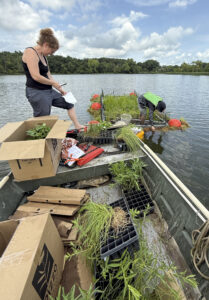LA to double recycled water capacity at Van Nuys wastewater plant – LAist

Report on Los Angeles’ Water Recycling Expansion Initiative
Introduction: Enhancing Urban Water Resilience
The city of Los Angeles has announced a significant infrastructure project to double the water recycling capacity at its wastewater treatment facility in the San Fernando Valley. This initiative represents a critical step in the city’s strategy to enhance water security and promote sustainable urban development, directly aligning with several key United Nations Sustainable Development Goals (SDGs).
Alignment with Sustainable Development Goals (SDGs)
The expansion project is a strategic investment that addresses global sustainability targets by focusing on resource efficiency, climate resilience, and responsible infrastructure development. The initiative’s contributions to the SDGs are multifaceted.
SDG 6: Clean Water and Sanitation
The project is fundamentally aimed at achieving SDG 6, which seeks to ensure the availability and sustainable management of water and sanitation for all. By doubling its recycling capacity, Los Angeles will:
- Substantially increase water-use efficiency and ensure a sustainable supply of freshwater to address water scarcity.
- Implement integrated water resources management by creating a reliable local water source, reducing dependence on imported water.
- Protect and restore water-related ecosystems by decreasing the need for large-scale water diversions from natural sources.
SDG 11: Sustainable Cities and Communities
This initiative directly supports the goal of making cities inclusive, safe, resilient, and sustainable (SDG 11). The key contributions include:
- Enhancing the city’s resilience to climate-related hazards, particularly prolonged droughts, by securing a local, drought-proof water supply.
- Reducing the adverse per capita environmental impact of the city by promoting a circular economy approach to water management.
- Supporting the development of sustainable and resilient infrastructure that serves the needs of the urban population.
SDG 13: Climate Action
As a critical climate adaptation measure, the water recycling expansion strengthens the city’s ability to cope with the impacts of climate change, a core objective of SDG 13.
- It strengthens resilience and adaptive capacity to climate-related hazards by diversifying the city’s water portfolio.
- It contributes to climate change mitigation by reducing the energy consumption and associated carbon emissions required to import water over long distances.
SDG 9: Industry, Innovation, and Infrastructure
The project embodies the principles of SDG 9 by investing in resilient infrastructure and promoting clean, environmentally sound technologies.
- The upgrade of the wastewater plant constitutes a significant development in quality, reliable, and sustainable infrastructure.
- It promotes resource-use efficiency and encourages the adoption of advanced water recycling technologies.
Project Implications and Strategic Outlook
Doubling Capacity for a Secure Future
The plan to double the recycling capacity at the Valley plant is a direct response to the increasing pressures of climate change and population growth on regional water resources. This expansion will transform the facility into a more significant contributor to the city’s overall water supply, marking a shift from a linear model of water use to a circular one.
Conclusion: A Model for Sustainable Water Management
The expansion of Los Angeles’ water recycling facility is more than an infrastructure upgrade; it is a strategic action that comprehensively addresses multiple Sustainable Development Goals. By advancing towards greater water self-sufficiency, the city is building a more resilient and sustainable future for its communities. This project serves as a powerful example of how municipal actions can directly contribute to achieving global sustainability targets, particularly SDG 6, SDG 11, and SDG 13.
Analysis of Sustainable Development Goals (SDGs) in the Article
1. Which SDGs are addressed or connected to the issues highlighted in the article?
The article on Los Angeles’s plan to double water recycling capacity at the Van Nuys wastewater plant connects to several Sustainable Development Goals (SDGs). These goals are relevant because the project focuses on sustainable water management, urban infrastructure development, resource efficiency, and climate resilience.
- SDG 6: Clean Water and Sanitation: This is the most directly related SDG. The article’s core topic is wastewater treatment and water recycling, which are central to ensuring the availability and sustainable management of water.
- SDG 11: Sustainable Cities and Communities: By investing in critical infrastructure to enhance water security, the city of Los Angeles is working to become more resilient and sustainable. This project is a key component of urban planning for a sustainable future, especially in a water-scarce region.
- SDG 12: Responsible Consumption and Production: The initiative promotes the efficient use of a vital natural resource—water. Water recycling is a prime example of a circular economy principle, moving away from a linear model of water use to one that emphasizes reuse and sustainability.
- SDG 13: Climate Action: Enhancing local water supplies through recycling strengthens the city’s resilience to climate-related hazards, particularly droughts, which are becoming more frequent and severe due to climate change. This action represents a crucial adaptation strategy.
2. What specific targets under those SDGs can be identified based on the article’s content?
Based on the article’s focus on doubling water recycling capacity, the following specific SDG targets can be identified:
-
Target 6.3: By 2030, improve water quality by…substantially increasing recycling and safe reuse globally.
- Explanation: The project described in the article—doubling the recycled water capacity at the Van Nuys wastewater plant—is a direct action aimed at substantially increasing water recycling and reuse within Los Angeles.
-
Target 6.4: By 2030, substantially increase water-use efficiency across all sectors and ensure sustainable withdrawals and supply of freshwater to address water scarcity.
- Explanation: By recycling wastewater, the city reduces its dependence on traditional freshwater sources. This increases overall water-use efficiency and helps ensure a more sustainable water supply, directly addressing the challenge of water scarcity.
-
Target 11.5: By 2030, significantly reduce…direct economic losses…caused by disasters, including water-related disasters…
- Explanation: Increasing the local water supply through recycling enhances the city’s resilience to droughts, which are a form of water-related disaster. This proactive measure can mitigate the economic and social impacts of future water shortages.
-
Target 12.2: By 2030, achieve the sustainable management and efficient use of natural resources.
- Explanation: Water is a critical natural resource. The project exemplifies sustainable management and efficient use by treating and reusing wastewater, thereby minimizing waste and maximizing the value of the available water resources.
-
Target 13.1: Strengthen resilience and adaptive capacity to climate-related hazards and natural disasters in all countries.
- Explanation: This infrastructure project is a key climate adaptation measure. It builds the city’s capacity to cope with the impacts of climate change, specifically the increased risk of drought, by creating a more reliable and climate-independent water source.
3. Are there any indicators mentioned or implied in the article that can be used to measure progress towards the identified targets?
Yes, the article implies a clear and measurable indicator for tracking progress:
-
Indicator: Increase in water recycling capacity.
- Explanation: The headline and meta description explicitly state that the city plans to “double capacity” at the Van Nuys wastewater plant. This provides a specific, quantifiable metric to measure the project’s success. This measure can be directly linked to SDG Indicator 6.3.1 (“Proportion of domestic and industrial wastewater flows safely treated”), as the project increases the volume of wastewater that is treated to a standard suitable for reuse. The progress can be tracked by measuring the plant’s output of recycled water in millions of gallons per day (MGD) before and after the upgrade.
4. Summary Table of SDGs, Targets, and Indicators
| SDGs | Targets | Indicators |
|---|---|---|
| SDG 6: Clean Water and Sanitation | 6.3: Substantially increase recycling and safe reuse globally. 6.4: Substantially increase water-use efficiency and ensure sustainable supplies of freshwater. |
The doubling of recycled water capacity at the Van Nuys wastewater plant. |
| SDG 11: Sustainable Cities and Communities | 11.5: Reduce the impact of water-related disasters (e.g., droughts). | Implementation of infrastructure projects that enhance resilience to drought. |
| SDG 12: Responsible Consumption and Production | 12.2: Achieve the sustainable management and efficient use of natural resources. | The volume of water being recycled and reused, contributing to resource efficiency. |
| SDG 13: Climate Action | 13.1: Strengthen resilience and adaptive capacity to climate-related hazards. | Increased local water supply as a measure of enhanced adaptive capacity to drought. |
Source: laist.com
What is Your Reaction?
 Like
0
Like
0
 Dislike
0
Dislike
0
 Love
0
Love
0
 Funny
0
Funny
0
 Angry
0
Angry
0
 Sad
0
Sad
0
 Wow
0
Wow
0
















































:focal(1500,1000)/https://media.globalcitizen.org/a6/9a/a69a4720-d8a1-4715-b596-18738d03c05c/rotary_polio_hero_image.jpg?#)







/countries/sri-lanka/photo-credit---dmc-sri-lanka.tmb-1200v.jpg?sfvrsn=dc298bcc_1#)



















